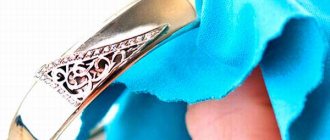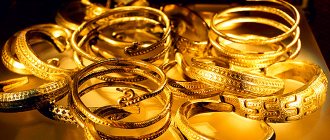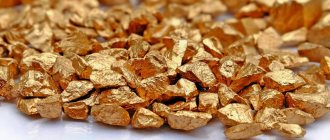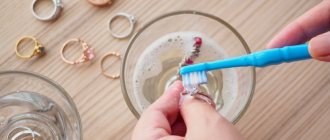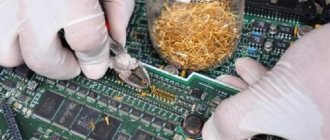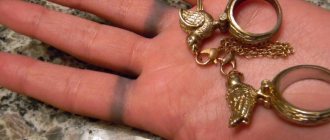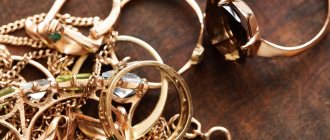Current gold standard standards in Russia
A sampling system was introduced to determine the quantitative content of precious metal in the alloy. Such additives are called ligatures.
Gold purified from impurities has a purity of 999.9. Metal of such purity can only be found in bank bullion. Jewelers can make an alloy with any proportion of precious metal.
Absolutely all products made of precious metals that are sold through retail chains or imported are subject to testing. This process is under state control. The Assay Office authorities apply a special mark to each product - a stamp confirming the sample of the alloy.
To systematize branding, state sample systems have been adopted. The most common of them at present are metric and carat.
Metric
It was introduced into the USSR in 1927 instead of the spool valve. Determines the number of units of gold in 1000 units of jewelry alloy. Modern gold jewelry is hallmarked with 375, 500, 585, 750, 900, 958, and 999 hallmarks. Used 583 until 1999. Changed to 585 to match Western 14K value.
Zolotnikovaya
Operated in Tsarist Russia, then in the Soviet Union until 1927. Measurements were based on a weight measure of one pound. The spool is 1/96th part. The most commonly used spool samples are 56, 72, 92. Such markings can still be found on antique products.
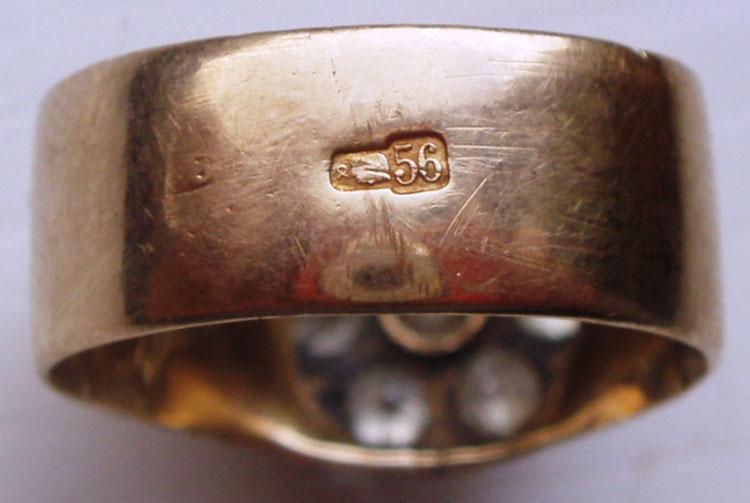
Carat
This is the British marking system, common in Western Europe and the USA. A carat is a unit of weight equal to 0.2 g. One thousand units of the metric system corresponds to 24 carats.
24K gold is pure, without the addition of ligature. In jewelry production, 9, 10, 14, 18 carat samples are used. To convert the value into the usual metric ones, you need to divide the value in K by 24 and multiply by 1000.

Methods for checking a gold product
It happens that they try to sell low-grade gold jewelry as high-grade gold. There are cases of obvious fraud when a product made of yellow metal is sold as gold. Foreign inclusions can be soldered into large elements to make them heavier.
Massive jewelry is often counterfeited. Fraudsters won’t make much money on a small product with decorative elements. Jewelry work is too expensive.
How can you tell if a piece of jewelry is gold? There are ways to check this at home. Some testing tools are readily available and can be found in every home. Others are more specialized and will require additional costs. Sometimes you can't do without the help of an expert. Let's consider all existing methods of checking gold for authenticity.
Visual
It is better to examine the decoration through a magnifying glass. There are professional devices with tenfold magnification. Serious defects can be seen with the naked eye.
The object is examined from all sides - external, internal, side. You need to pay attention to the following nuances:
- joints;
- absence of a state stamp indicating the sample;
- presence of a metallic odor;
- heat transfer;
- color unevenness;
- sound when falling.
Mechanical
Such methods are based on the physical properties of the metal - softness, thermal conductivity, weight, density, ductility. Mechanical testing will require special equipment;
- touchstone;
- electronic detector;
- magnet;
- scales;
- a needle or small file for scratching (if you are not afraid of damaging the jewelry).
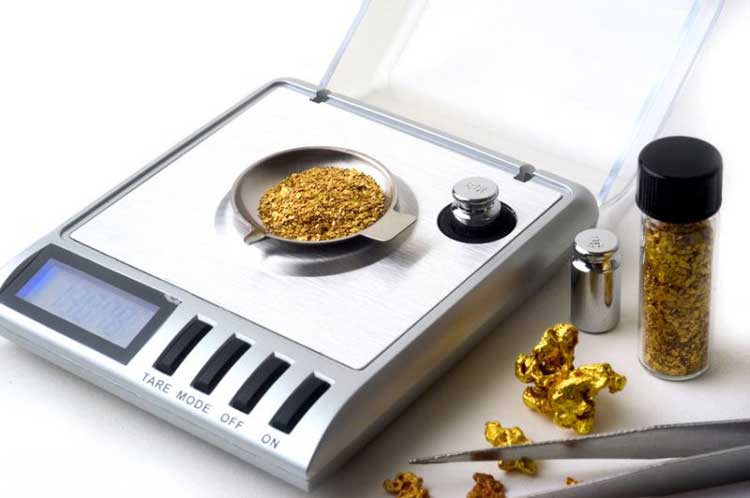
Chemical
Gold is chemically inert to most acids. This means that the metal does not react with them. Aqua regia dissolves the noble metal. It has nothing to do with alcoholic beverages. It is a mixture of nitric and hydrochloric acids.
The reaction is assessed by the degree of oxidation of the metal. Acids and chemical reagents are not stored at home, and getting them is quite difficult. Here is a list of household means for checking:
- lapis pencil;
- iodine;
- vinegar;
- ammonia;
- black bread.
I’ll tell you below what to do with all this.
Drop some iodine
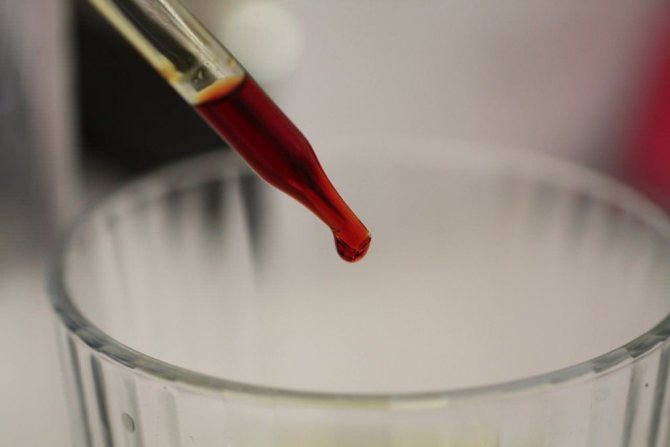
Rub the product on jeans or other thick fabric, then drop iodine on this place on the metal. High standard gold does not darken. If the metal has darkened (this may appear within a minute), the product is not genuine or the standard is not too high.
But brass and copper do not change color from iodine either. So this testing method is good for high-grade gold, but it is not enough on its own.
We do not recommend testing products with iodine levels of 585 or lower. After iodine, you will definitely have to polish them or remove stains with ammonia; traces may remain.
Visual methods
Often, fakes can be recognized by carefully examining the product. The inspection is carried out from all sides, not only from the front. Joints and soldered elements are hidden in places that are invisible at first glance.
A magnifying glass will be a good aid in inspection. If you don’t have a magnifying glass with you, you can take a photo of the hallmark with a camera on your smartphone and examine it in detail under magnification.
Numbers, letters, and outer borders of the mark must be clear and even. Counterfeits are often branded using artisanal methods. The elements will be positioned crookedly, at different distances from each other.
The surface of the gold jewelry should have a uniform color. Scuff marks indicate that spraying has been applied. The coating can be of different thicknesses. If it is thick enough, the outer gold shell will not fray. In this case, solder lines of different colors will be visible. On gold jewelry they should only be at the joints of the parts.
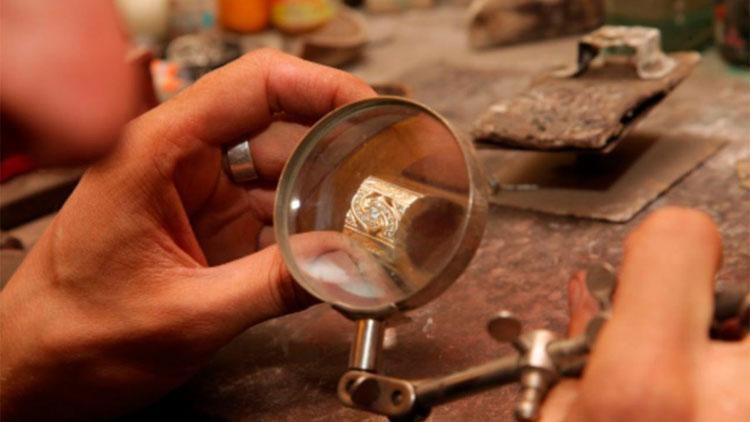
Pay attention to discolored areas. Shades of yellow of varying intensity indicate poor quality of the alloy. If during smelting the precious metal was poorly mixed with the alloy, even an experienced jeweler cannot determine the sample size and value of such a product.
White gold is popular now. This color is given to the alloy by adding palladium and silver to the alloy. A product with gold hallmark will still have a visible yellowish tint, a warm yellowish tint. Other white metals do not have such a yellowish tint.
Smell the product
The gold product should not have any odors. This is one of the few metals that “do not smell.” Only platinum and palladium have this property. But they are more expensive than gold. It is not at all profitable for scammers to pass off platinum jewelry as gold. Even silver has a smell.
Jewelry is not just something to be smelled. It should be clenched in your fist and held for a couple of seconds. Then open your palm and smell.
A pronounced metallic smell indicates a fake.
This is how the thermal conductivity of the metal is assessed. Gold will not cool the skin.
Take a closer look at the joints
The joints of the decoration parts are soldered with gold of a higher standard. They have a lighter (sometimes greenish) tint. Solder lines are visible at the junctions of chain link elements.
There should be no lines of light yellow or green on the surface of the decoration. This may mean that a weighting agent is soldered inside.
Look at the gold in the sun and in the shade
Precious metal does not lose its shine in low light. This distinguishes gold from other yellow metals and alloys. Look at the decoration in different lighting conditions.
The intensity of the shine should be maintained. If the item is gold plated, it will fade under bright light. A thin layer of gold plating loses its ability to reflect light.
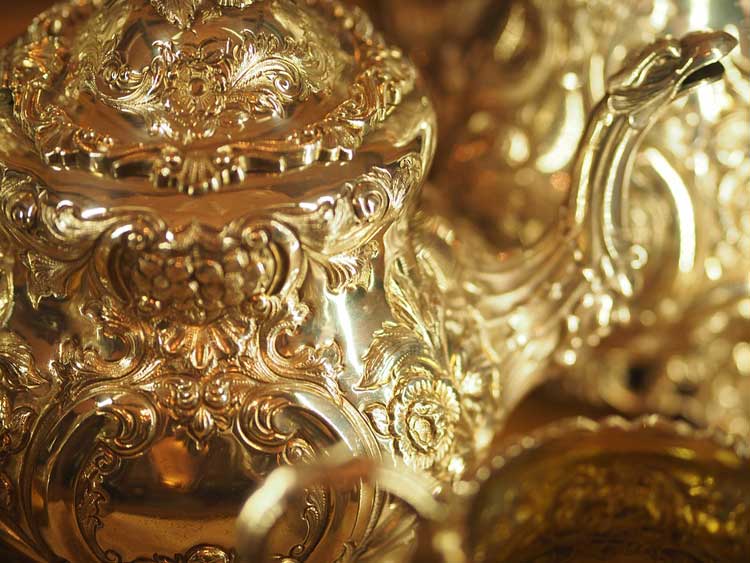
Gold: what is it?
Rare earth precious metal yellow in color. Does not oxidize and does not lose its properties over time. Due to its plasticity and softness, it can be easily processed using both cold and melting methods. Its softness does not allow it to be used as jewelry in its pure form.
To make jewelry, harder metals are added to give it hardness, such as silver or copper. All so-called gold jewelry are alloys.
Any jeweler is well aware of the ratio of gold in the alloy. Some of them, especially unburdened by conscience, use this knowledge for their own selfish purposes. But there are some rules that can help determine whether the gold you are being offered is real or a cheap fake.
Buy gold only in reputable jewelry stores operated by jewelry factories, but not in boutiques and small stalls. The cost will, of course, be more expensive, but there will be less risk of buying a fake.
A real ingot must be marked with data about the sample. A careful study of the tag will tell you about the manufacturer, the price per gram and for the entire jewelry as a whole, weight, sample. There must be an OTK stamp. The sample indicates the content of pure gold in the jewelry.
The most popular are 585 and 750. This means that they contain 58.5% and 75% pure gold, respectively. When the sample is found, you should carefully examine the clasp of the bracelet or earring. If there are scratches on them, then you should not take this product.
The reason here is the following. In bracelets, chains and earrings, the sample is placed on the clasps. And suppliers only send locks for inspection and, after inspection, calmly place them on gold-plated fakes.
Finally, you should find the logo or imprint of the manufacturing company on the reverse side of the jewelry. The method described now relates to the visual assessment of gold.
But this is also not an indicator of reliability, since in Turkey, for example, they can give you any test before your eyes. Yes, and not only there. A fuzzy, blurry sample is the first sign of a fake; such gold should not be taken. The second detail that you should pay attention to is the inside of the product, which should be perfectly mirror-like, without any irregularities or roughness.
Mechanical methods
The basis of such methods is knowledge about the physical properties of gold and its alloys. A gold product makes a specific sound when falling, is not magnetic, and has a certain density. There are instruments that determine the composition of the alloy and its sample based on electrical conductivity.
Electronic detector
A device for assessing the quality of an alloy is quite expensive and is rare. The detector also uses a reagent designed for a certain number of reactions. For single checks of the authenticity of jewelry, its use is too expensive.
The device itself determines the following indicators:
- type of metal;
- alloy composition;
- ligature share;
- sample
Some devices work in the cut. In others, the sensor is applied to the surface of the product. There are mobile devices with a battery and those operating from the network.
The most popular of them is the DeMon electrochemical detector. It performs a quick analysis by assessing the electrochemical potential of a surface. During inspection, no cuts are made, which means the appearance of the decoration is preserved. A few square millimeters of area are sufficient to measure. Using DeMon, you can determine the homogeneity of the alloy and its sample by applying the sensor at different points. By the way, here is a video of how this device works.
Assay needles or touchstone
A touchstone is a black plate on which a line is drawn with a noble metal and the sample is determined by its color. To make it, take a block of siliceous slate, such as black jasper.
The plate serves as a background for determining the composition of the alloy. A line is drawn on the stone with pressure on the product being examined. A strip is drawn nearby using a special assay needle that comes with the stone. A standard set of needles includes six rods with sample standards from 333 to 999.
The alloy sample is preliminarily determined by the saturation of the strip. Then use a glass rod to drip the reagent onto the rubbed areas. The chemical reaction occurs only with the ligature. The final conclusion is made based on the degree of oxidation. The darker the color, the lower the gold content and the lower the purity.
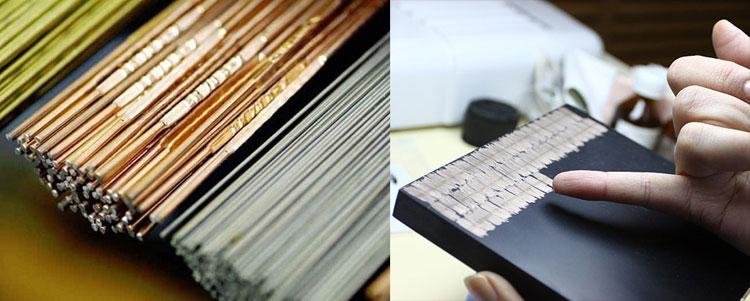
Compared to sawing, this is a gentle method. It is relevant and less destructive for small products.
How to clean a touchstone
After the checks have been carried out, the surface of the stone is mechanically cleaned of any leftover cuts, reaction residues, and sediment formed. The stone is lubricated with nut, almond or cedar oil, then wiped dry.
Archimedes' method
It is based on the dependence discovered by Archimedes of the density of a substance on the water it displaces. Data from weighing the product in water and air are substituted into the formula. Even a small error in calculations affects the result. The method is troublesome and is used quite rarely.
Hydrostatic weighing is relevant for massive objects without cavities or voids. At home, you can put the product in a glass of water. Gold has a fairly high density coefficient compared to other metals and sinks quickly.
Magnet
Precious metals are not magnetic. However, non-ferrous metals - copper, aluminum, brass - also do not react to magnets. Therefore, the method will not reliably show the quality of the gold product, and therefore its purity.
If you have a magnet on hand, you can attach it to the jewelry. Surfaces will be attracted if the alloy has a high iron content or gold plating is applied to a base magnetic metal.
Sound
Monolithic products can be checked by the sound with which they hit a hard, smooth surface. A table, tiles, laminate will do. Gold falls with a ringing clear sound. If the sound is low or dull, it means that something other than gold has fallen or there is a foreign inclusion inside the product.
The method is not very reliable; it will not be possible to accurately determine the sample. This way you can only indirectly judge what metal the product is made of. Only a person with keen hearing can hear the differences in sound. The method is generally not suitable for testing ingots and chains.
Scratches
If you scratch the jewelry with a sharp object or a small file, you can identify a fake with a thin layer of gold plating. There will be a noticeable change in color within the product.
If the coating is thick enough, you won’t be able to reach the inside of the product with a scratch. You can use a professional diamond-coated needle file. The main thing is not to overdo it - too deep a cut will damage the appearance of the product, and small scratches can be easily removed by polishing.
Swipe gold over tile or unglazed porcelain
This method reliably determines whether the product is gold, but does not reveal its purity. For the test you will need unfired ceramics, porcelain without glaze. A piece of ceramic tile or dishes will do.
Using the product being tested, you need to draw a stripe on the ceramic. The precious metal will leave a golden mark. The base metal will leave a gray, black trace.
Attach a magnet

Plating steel or other alloys with a high iron content with gold or its imitation is a common practice. Only ferromagnets are strongly magnetic - iron, cobalt, nickel, gadolinium, terbium, dysprosium, holmium, erbium, thulium.
Dimagnets (for example, water or table salt) and paramagnets (aluminum, etc.) are weakly magnetic. All non-ferrous metal is not magnetic.
If it happens on the beach or in places where tourists gather, buy the cheapest magnet in a souvenir shop and attach it to the product. If it sticks, it’s definitely a fake or the metal is of too low standard (too many iron impurities). If not, perform other checks.
Chemical methods
Gold is an inert metal. It does not react with many chemicals. The ligature reacts mainly. Experts use acid reagents for various gold samples. In everyday life, you can use iodine, ammonia, vinegar, lapis pencil or even black bread.
Iodine and vinegar
Gold is the only metal that does not react with iodine. Before applying iodine, the surface of the product must be cleaned, for example, by rubbing it on a thick cloth. If the metal is not precious, the iodine will darken the area. High grade gold will not react. The degree of burn can be used to judge the alloy sample. The iodine trace is removed by wiping with ammonia or soaking in Coca-Cola.
Every home has a bottle of vinegar. It can also be used to check the authenticity of gold. The product must be immersed in a glass of vinegar for at least five minutes. If it gets dark, it's fake. Real gold alloy vinegar is not afraid!
Black bread
Such a check will require time and black bread. The crumb is wetted in water. The resulting mass is tightly wrapped around the product. You can break the crumb after it has completely dried.
You should carefully inspect the inner surface of the bread mass. Green, dark spots indicate oxidative processes that are not typical for high-grade gold.
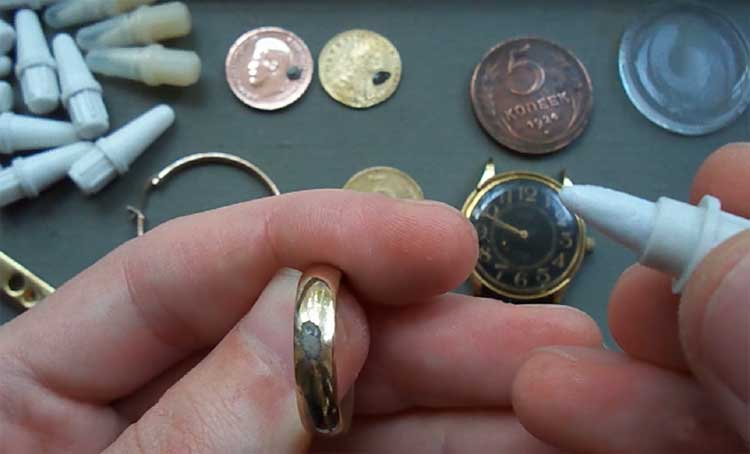
lapis pencil
Lapis is sold at the pharmacy. It is an antiseptic used to stop bleeding. You can check gold using it as follows:
- make a notch;
- moisten the pencil with water;
- anoint the sawed area;
- wait up to 5 minutes for a reaction.
Gold does not react to lapis. An oxidized mark will remain on a fake or low-grade gold alloy.
Ammonia
Ammonia (ammonia) does not leave any traces on the surface of gold. The substance is even used to clean jewelry. If cloudiness or a dark mark appears on the surface, it is not a precious metal or gold plated. It is impossible to accurately determine the sample using this method.
Test with vinegar
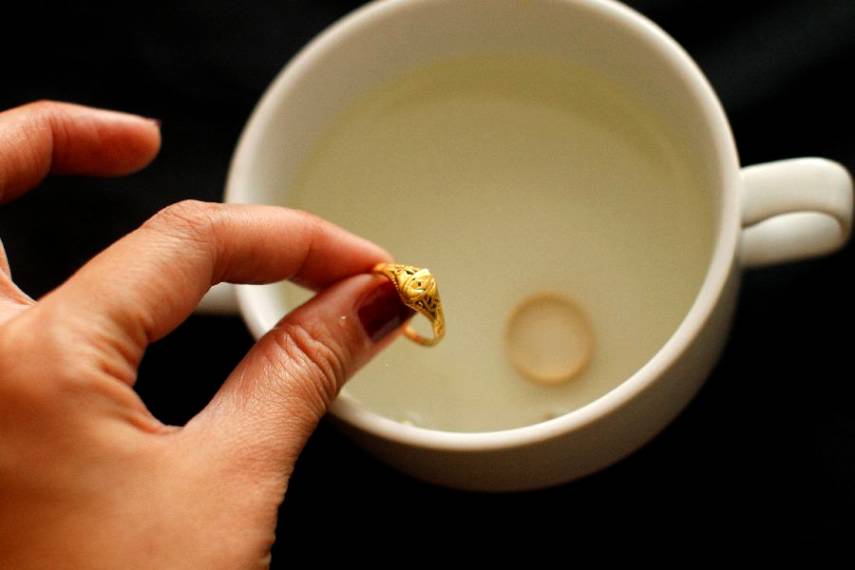
Tell the seller that you will test the gold with vinegar. Are you nervous? There’s no need to run to the grocery store anymore. But a professional who is confident in his product will not sweat it.
Fake gold quickly darkens in vinegar - just pour a little into a glass and hold the metal in it for about five minutes. But real high-grade metal doesn’t care about anything.
Other methods
To assess the quality of a gold product, it is better to use the services of a specialist. Appraisers in a pawn shop or jewelry store know exactly all the intricacies of checking the authenticity of gold, and their workplaces are equipped with special instruments and reagents.

Go to the pawn shop
Appraisers deal with dozens, even hundreds of items every day. They have magnifying glasses, needle files, and testing reagents at their disposal. For example, testing with gold chloride is only available from a specialist. This chemical is difficult to find commercially. The assessment service may be subject to a fee.
Life hack: if you pretend to be a potential client and then change your mind about selling, you can save money.
Go to a jeweler
The jewelry workshop also has the acids necessary to test gold. Craftsmen who work with crowbar purchase special devices, for example DeMon. The services of checking the authenticity of jewelry and determining the sample will cost up to 1000 rubles.
What is the difference between gold and gilding?
The decoration consists entirely of gold alloy - both inside and outside. Gilding is only the top layer of the product. The product is made from another metal, and only gold is sprayed on top, so some of the methods described above are not suitable for determining authenticity (for example, methods for determining authenticity in the sun or using iodine).
Gilding is most easily determined using the needle or nail file method, which were described above. The top layer is easy to wash off. And if there is yellow metal inside, run it across the ceramic, it will definitely leave a black mark.
It is also important to know that gold-plated products are not hallmarked, so they are easy to distinguish. But the sample is not a guarantee of quality; it is placed on individual parts of the product. Therefore, read on, how not to be deceived by scammers in the gold market?
Video on how to identify real gold.
How not to determine a sample
When buying gold secondhand, even from a friend, it is advisable to use as many methods as possible to verify its authenticity. Restrictions apply to methods that may cause irreparable damage to the product or the health of the examiner. Naturally, you should not find out that inside the ring, cutting the product in half, breaks off any parts. After this, its jewelry value becomes zero. This is no longer a decoration, but a scrap.
Old-fashioned method for teeth
The softness of gold explains the ability to leave teeth marks on its surface. This method is not good for tooth enamel. When biting, microcracks appear on it, which can lead to the development of caries or tooth destruction.
By the way, this method does not provide a 100% guarantee of protection against counterfeiting. Aluminum and lead also retain dental marks. Often the print cannot be corrected or polished.
The jewelry and teeth will be hopelessly damaged. And for what?
Test with black bread
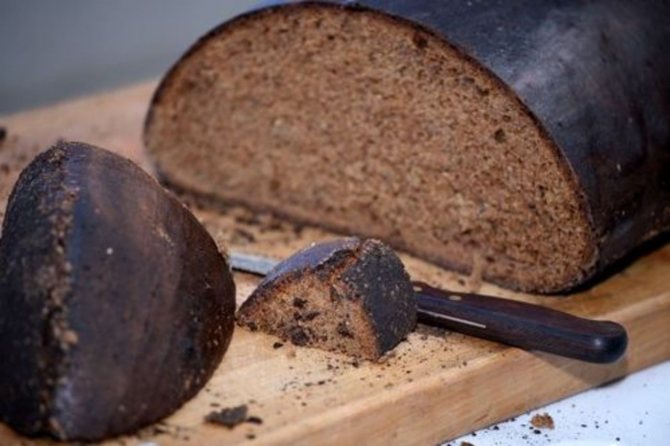
The method is safe (for real gold!), but slow. Take the crumb of black bread, remember, mix with water and stick the mixture onto the product. Leave it until the bread crumb turns into a dry crust, then break it apart.
If there are dark traces inside the crumb, it means the fake has oxidized. If not, then it is either gold or good gilding.
